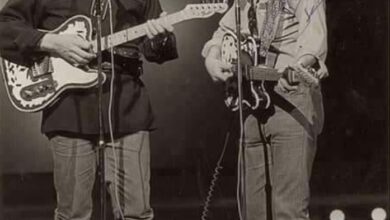Baroque Meets Rock: How “A Whiter Shade of Pale” Defined the 1967 Summer of Love
Procol Harum’s “A Whiter Shade of Pale,” released in 1967, has cemented its status as one of the defining songs of the 1960s. Known for its distinctive organ melody, reminiscent of Johann Sebastian Bach, and its abstract, poetic lyrics, the track stands out as a hallmark of the era’s musical landscape. Written by Gary Brooker and lyricist Keith Reid, the song achieved remarkable commercial success, dominating the UK charts for six weeks and reaching No. 5 in the US. Its unique blend of Baroque influences and rock music captured the essence of the “Summer of Love,” resonating with a generation searching for deeper meaning in both music and life.
The origins of “A Whiter Shade of Pale” are intriguing, with its creation often described as almost serendipitous. Gary Brooker had initially developed a musical idea influenced by classical themes when he encountered Keith Reid’s evocative lyrics. The two collaborated to create a piece that, while seemingly simple, holds layers of complexity. The inclusion of Matthew Fisher’s haunting organ arrangement added a depth that would become synonymous with the song. This rich musical tapestry, combined with Reid’s enigmatic narrative, invited listeners to explore various interpretations, from love and loss to existential inquiries, further enhancing the song’s allure.
The lyrics of “A Whiter Shade of Pale” are filled with literary references, including nods to Chaucer and Shakespeare. This poetic quality captivated audiences and sparked conversations about the song’s meaning. The abstract storytelling style allows for a multitude of interpretations, making it a favorite among listeners who enjoy dissecting lyrics for hidden messages. The song’s famous opening lines, which describe a woman in a “whiter shade of pale,” evoke vivid imagery and emotions, leaving much to the listener’s imagination.
Despite the song’s rapid ascent to fame, Procol Harum encountered legal issues in the years that followed. The band faced disputes regarding songwriting credits, particularly concerning the contributions of Matthew Fisher. These challenges served as a reminder of the complexities within the music industry, yet they did not overshadow the song’s legacy. “A Whiter Shade of Pale” continues to be celebrated as a timeless piece, influencing numerous artists across various genres. Its impact on musicians like The Beatles and Brian Wilson of The Beach Boys is well-documented, highlighting its significance in shaping the sound of the era.
Procol Harum’s formation in 1967 was a response to the burgeoning psychedelic rock movement. The band sought to combine American rhythm and blues with classical music elements, resulting in a sound that was both innovative and distinctive. Early performances helped establish their reputation, including a memorable moment when Jimi Hendrix joined them on stage. These encounters not only showcased the band’s musical prowess but also solidified their place in rock history.
Following the success of “A Whiter Shade of Pale,” Procol Harum continued to push the boundaries of progressive rock. Their willingness to incorporate classical influences into rock music set a precedent for future bands, allowing them to explore complex arrangements and themes. Albums like Shine On Brightly and A Salty Dog further showcased their innovative approach, solidifying their legacy within the genre.
Procol Harum’s contributions to music extend beyond this iconic song. The band has been recognized in various prestigious contexts, including induction into the Grammy Hall of Fame and the Rock and Roll Hall of Fame. Their work has been celebrated in documentaries and retrospectives that highlight the band’s role in the evolution of rock music, particularly in the integration of classical elements.
The legacy of “A Whiter Shade of Pale” is further evidenced by its cultural impact. The song has been featured in numerous films and television shows, becoming a staple of popular culture. Artists such as Annie Lennox have covered the track, each bringing their unique interpretation while honoring the original’s emotional depth. The song’s timeless quality ensures that it continues to resonate with new generations of listeners.
Procol Harum’s journey illustrates the dynamic nature of the music industry and the ever-evolving landscape of rock music. From their early beginnings to their lasting influence, the band has left an indelible mark on the genre. “A Whiter Shade of Pale” stands as a testament to their creativity and willingness to explore new musical territories, ensuring their place in the annals of music history.
As the decades have passed, “A Whiter Shade of Pale” remains a symbol of the 1960s and the transformative power of music. Its haunting melodies and evocative lyrics invite listeners to reflect on their own experiences, transcending time and cultural boundaries. Procol Harum’s ability to craft a song that captures the complexities of human emotions speaks to their artistry and the enduring appeal of their music, making “A Whiter Shade of Pale” a true classic that will continue to inspire and captivate for years to come.





